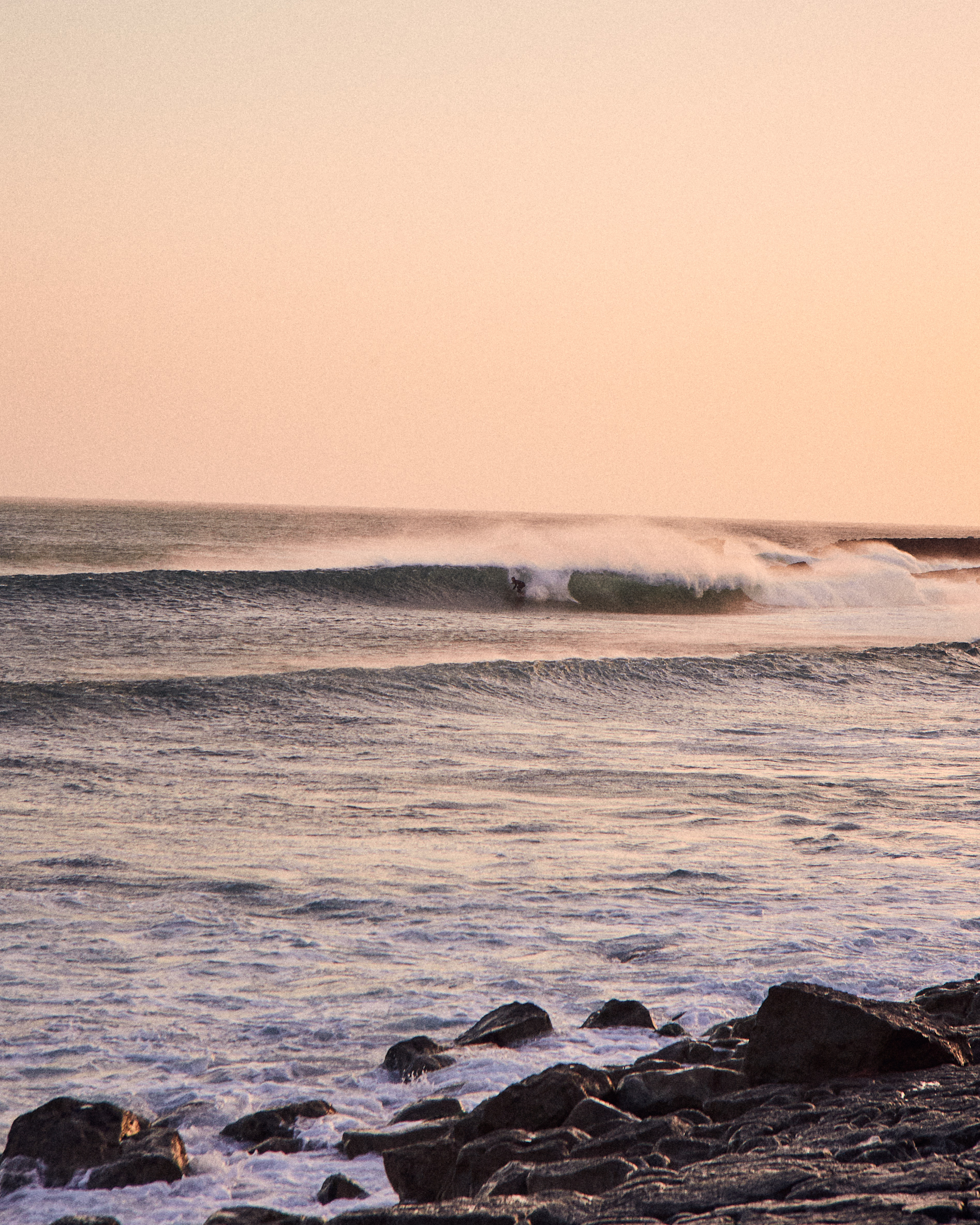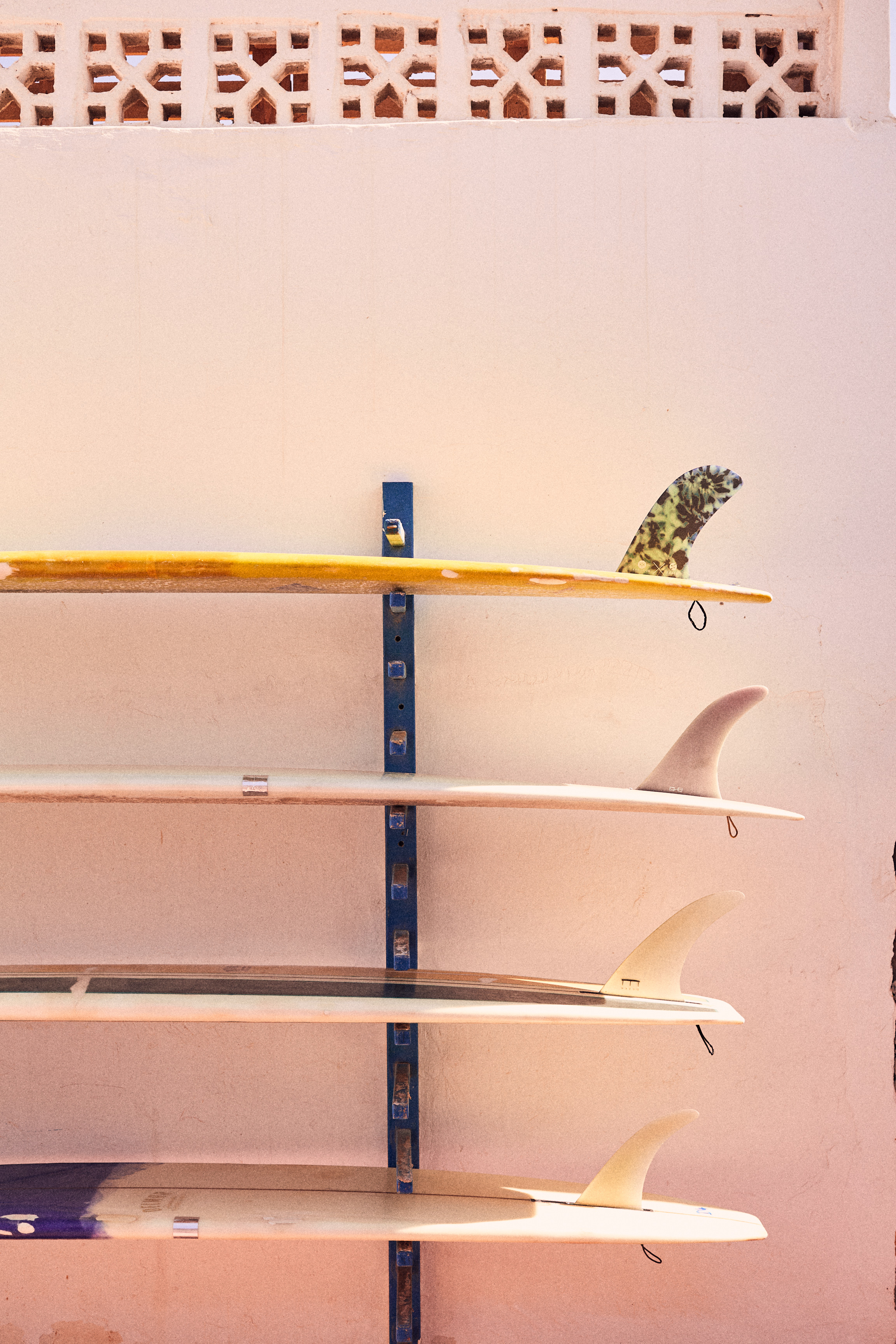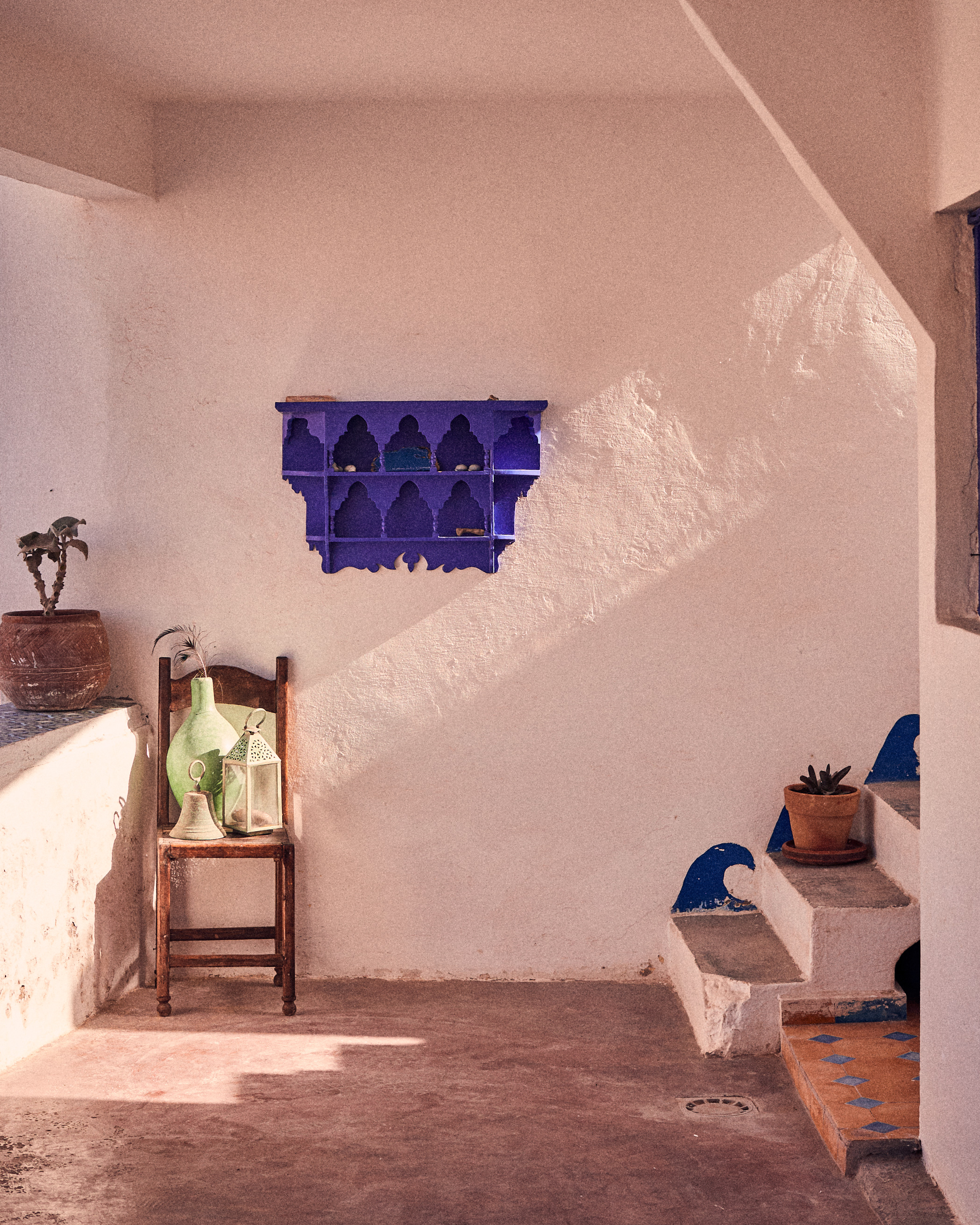Photography by Oliver Pilcher, with his video of Taghazout here
In little Taghazout, on Morocco’s clay-baked west coast, there’s an immutable rhythm to life. Every sunrise, the Call to Prayer rings out across the ragged cluster of fishermen’s houses, which rise from the beach like bad teeth. The low, long, quivering syllables of the mu’addhin wake the stray dogs, who bark in stereo through tight alleyways, where frayed pastel walls are daubed with psychedelic surf murals. The beach camels wake and rise in their oddly robotic way. The fishermen push off in identical blue wooden boats, followed on flat days by young men with rubber rings and flippers, floating into the limpid ocean in sodden tracksuits, spearguns in hand.
Most afternoons, after selling redfish and humpbacked dorado under Coca-Cola parasols, the fishermen play cards beneath the beachfront walkway. In the gloaming, the town’s kids often appear for a game of football on the sand, racing towards tiny goalposts, all shouts and stretched shadows. Goats clamber into the little argan trees in the scrub around town, eating the bitter fruit but unable to digest the nuts. Berber smallholders collect their precious piles of excrement to grind them into oil. Shiny hair, the backbreaking way.
The Call to Prayer also wakes the surfers and yogis, who have become the town’s unexpected lifeblood. Mats are unrolled, the prostrations at the mosque echoed by lissom yoga teachers on roof terraces, lingering on the Cobra Pose, essentially the surf take-off position. ‘Allahu Akbar’. ‘Let it be’. After dawn prayers, the smiling, long-bearded Fahd El Mania will look at the swell forecast and decide if he’s going to shape and fix surfboards that day – always working alone, entranced by the wave-like incantations of The Koran. Or, if he’s going to put a handwritten sign in front of his scrappy workshop and head for Killers, to surf under striated ochre cliffs, above seabed rocks that creak audibly under the ocean-heave. Locals will simply leave broken boards on the rocks for Fahd to pick up when he’s done.
After dawn prayers, the smiling, long-bearded Fahd El Mania will look at the swell forecast and decide if he’s going to shape and fix surfboards that day – always working alone, entranced by the wave-like incantations of The Koran.
The 32 bus, renamed the Surf Bus, arrives from Agadir and disgorges young Moroccan dudes with boards, Sideshow Bob hair and dreams their parents never had. Vans and battered Renaults load up for the drive towards Killers, Donkeys, Draculas or Boilers; Banana Point, Camel Point or Anchor Point. If the swells are pumping along the turmeric coast, business will be good in Taghazout: in the hole-in-wall surf shops selling second hand boards, dusty sex wax and fake Ray-Bans; in oceanfront restaurants that serve speargunned calamari to harem-panted girls on floor cushions, who yawn and nod chill-ly to boombox beats, happy to drink mint tea in a region where alcohol licenses require bureaucratic gymnastics. The fishermen fear the barreling swells the surfers dream of. It is a town dictated by the Moon.
I first came six years ago, and fell for Taghazout’s gentle rhythms; the raw otherness of the dusty landscape, a four-hour flight from London, but feeling so much further away. One orange morning, I surfed at Anchor Point, the most iconic wave in Morocco, by the rocky spit just north of town, graced by two sagging palm trees. A group of Australian surfers strayed here from the Marrakech Express hippie trail some time in the 60s, and found that they could ride the peeling right-hander for more than a kilometre, almost into town. For me, there was one wave, which started innocuously enough that I managed to scramble to my feet on my foam longboard. Then, somehow, it became a little shifting wall of glassy, orange-inflected blue, rising up in front of me, gently ushering me forward, easing and then building again with magic energy. It was barely 15 seconds, but I can still see and almost feel it.
During long, soft-focus afternoons on the blue-tiled terrace at the Panorama restaurant, manager Charif would greet me with a vertical handshake, wearing a ‘Work sucks, go surfing t-shirt’. The mint tea always took a while; one day, as a big swell rolled in, the calamari simply didn’t arrive. Walking the same alleyway on the way back to my spartan room in an old fishermen’s apartment, I’d be led by the same stray dog, and offered kif hashish by the same man in a mosaic doorway.
Coming back this year, the Panorama restaurant is now just dust and tiles. From its abandoned terrace, I look out over Taghazout Bay, a long sandy beach to the south of town which has been given over to foreign-brand hotels and whitewashed apartments. Poking through the palm trees and construction dust, they appear like a faintly absurd mirage from sea-worn Taghazout, where there’s still no ATM. The development has meant a slick new tarmac road through town, though that hasn’t prevented the gormless wanderings of the goats. There are a few more whitewashed, Maroc-styled cafes serving flat whites, and an elegantly curving Cali-retro skate park overlooking town. The best tagine still comes from the hole-in-wall restaurant beside the mosque.
On a spring Friday morning of underwhelming swell, I’m picked up by Yassine Bellqber, widely considered the best surfer in the area, for a cruise up the dry reddish coast – passing the lonely Cap Rhir lighthouse, and perhaps the greatest concentration of right-handed point breaks in the world. At 26, Yassine has a shoulder-length frizz, a model’s pout and a gently laconic air. Faintly rueful at the lack of swell, he starts to tell me his story, which in some ways is the recent story of Taghazout.
Yassine grew up in a self-built house facing Mysteries, a barreling reef break just north of Anchor Point, where surfers – ‘hippies’, as the locals still knew them – would come and park their camper vans. With his Arabic father fishing and working in a now-defunct fish factory, Yassine’s job was to sell his Berber mother’s donuts to the surfers, who knew him as Donut Boy. He learned to swear in at least six languages, and would tell the hippies that his mother’s wares – some banana-filled, others sprinkled with cinnamon – would bring them not just energy, but waves from the lunar gods. ‘If you got a laugh, you might get a sale,’ he recalls.
Yassine’s job was to sell his Berber mother’s donuts to the surfers, who knew him as Donut Boy.
With the lack of shops in Taghazout creating a seller’s market, Yassine also learned the art of the deal. When he was twelve, one Australian broke his surfboard fins during one of those days when Mysteries sucks and slams. Yassine offered him six donuts for the broken board. As the goods were traded, he asked in his kindest voice if he could have the plate back when the man was finished eating.
Yassine learned to surf instinctively, just like he learned donut salesmanship – his first lesson being that you really do need fins. But he was a natural. And, one day, he sold some cinnamon donuts to Ben O’Hara and Ollie Boswell, two friends from Swansea university, who’d first come here to surf in the late 90s, and had become regulars at Mysteries. In 2003, they opened Surf Maroc, Taghazout’s first surf camp, cleaning up a series of decrepit fishermen’s apartments and adding hammocks, Fez pouffes and shisha pipes. As Surf Maroc grew, it spawned imitators, and today there are almost 30 surf camps in town, trading in Omega-rich communal dinners, rooftop yoga and surf lessons from locals.
Surf Maroc’s fourth property, Amouage, is one of a few recent openings that have smartened the place up. Once a tired guesthouse on the edge of town, it’s now an airy, whitewashed place with a Soho Beach Club vibe. Along with the elegantly eccentric Munga Guesthouse down the road – a fantastical feat of wild carpentry, with a fairylit terrace restaurant and driftwood rooftop bar – it has helped draw a crowd of surfers who grew up.
As the business grew in the noughties, Ben and Ollie noticed that the chippy kid who had sold them donuts was tearing up the local breaks. They began buying Yassine boards, paying for him to go to surf competitions and giving him a fair wage to teach Surf Maroc’s increasingly upmarket guests. One of them was the granddaughter of the sculptor Barbara Hepworth, over from London to surf. She’s now his girlfriend, and they’ve just come back from a ski trip to the Alps. ‘People round here think it’s pretty funny,’ admits Yassine. ‘This kid from Mysteries, learning to ski.’
He’s telling me this as we enter the water off the long pebble beach at Tamri, an hour up the road from Taghazout, bookended by cliffs like collapsed sandcastles; a Rothko duotone of blue and orange. It’s exhaustingly choppy, my shoulders aching as I lie splattered on my board. There is no repeat of that magic wave at Anchor Point. Yassine, meanwhile, paddles mostly with one hand, and surfs the chop with the faintly disinterested grace of a Venetian gondolier. When I ask how, he shrugs that he can feel the water.
Yassine paddles mostly with one hand, and surfs the chop with the faintly disinterested grace of a Venetian gondolier.
Afterwards, salty-haired and ravenous, we eat nutty, argan-fed goat tagine with our hands out the back of a restaurant in the devout little town of Tamri, known for its small, sweet bananas. Sitting at a pink table, as chansons d’amour bleed from a battered radio, my arms are splattered with sticky turmeric-yellow. As we leave the dusty, slow-motion place, Yassine buys a bunch of bananas, which we eat in silence as we pass more little settlements of blocky buildings, like shards of lost citadels, deserted in the name of Allah. With a warm wind rushing through the van, we toss the little peels out the windows, careful not to hit donkeys and dreadlocked hitchhikers.
The little fishing village of Imsouane, an hour north of Taghazout, is said to be the next big thing, with Surf Maroc planning to open a camp here to access the consistent breaks just off the little town, including Cathedral Point and The Bay, where Yassine swears that even hacks like me can plop in at the harbour and surf 800-metre waves. There’s a pastel-pink lighthouse by the harbour, and a plastic-table restaurant where the fishermen plonk their catch by the grill. The rest is rawer, more stoner-slow than Taghazout – fishing nets, graffiti-scrawled abobe, strains of Moroccan reggae.
On the way back, we stop by the roadside to meet one of the groups of women who pick mussels on the rocks with medieval-looking picks, lugging them to the roadside on donkeys and cooking them under burning clumps of shrub, ready to sell to passing drivers. There are around ten women in this group, all from a village near Tamri; wearing headscarves, sea-beaten abaya cloaks and plastic sandals, faces lined with life. One hands me a wizened mussel in charcoaled hands. It’s chewy, smoky, tasting more of land than sea. Yassine translates their Berber: one is called Fatma and another called Fatna, which is amusing even to them. ‘We’ll be rich soon!’ Fatma cackles with cheery irony. We laugh, and chew.
That evening, I’m by the Yves Klein-blue infinity pool at the Amouage, the XX bleeding through the speakers, a bassline to low conversations over mojitos, in French, German, New Jersey. Looking out towards Anchor Point, I see a lonely rubber ring floating back to shore in the half-light. I wonder if he has a squid or an octopus in there, or if nature has eluded him for another day. That night, I’ll will myself to sleep with thoughts of that wave, but will dream of stranger things. At sunrise, the Call to Prayer will ring out. And it will all begin again.













